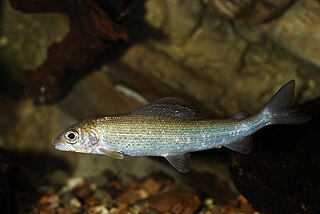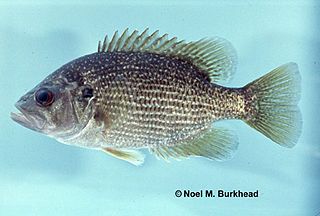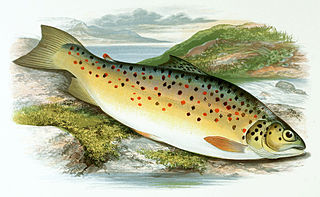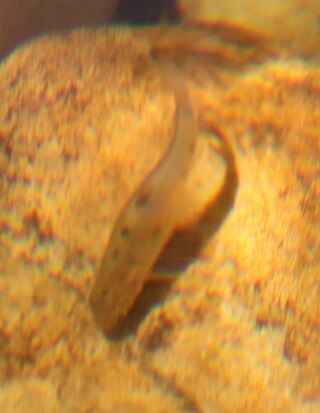
Lake Tanganyika is an African Great Lake. It is the second-oldest freshwater lake in the world, the second-largest by volume, and the second-deepest, in all cases after Lake Baikal in Siberia. It is the world's longest freshwater lake. The lake is shared among four countries—Tanzania, the Democratic Republic of the Congo (DRC), Burundi, and Zambia, with Tanzania (46%) and DRC (40%) possessing the majority of the lake. It drains into the Congo River system and ultimately into the Atlantic Ocean.

The Neretva, also known as Narenta, is one of the largest rivers of the eastern part of the Adriatic basin. Four hydroelectric power plants with large dams provide flood protection, electicity and water storage. The Neretva is recognized for its natural environment and diverse landscapes.

Thymallus thymallus, the grayling or European grayling, is a species of freshwater fish in the salmon family Salmonidae. It is the only species of the genus Thymallus native to Europe, where it is widespread from the United Kingdom and France to the Ural Mountains in Russia, and Balkans on the south-east, but does not occur in the southern parts of the continent. It was introduced to Morocco in 1948, but it does not appear to have become established there.

The Roanoke bass is a species of freshwater fish in the sunfish family (Centrarchidae) of order Perciformes. This species is endemic to rivers in the eastern United States of America, where it is native only to the states of Virginia and North Carolina.

The Barca snakehead is a rare species of snakehead. It is endemic to the upper Brahmaputra river basin in northeastern India and Bangladesh. Records from Nepal are of doubtful validity. Overall it has been assessed as data deficient by the IUCN, and in 2014 it was assessed as critically endangered in Bangladesh by the IUCN. In Assam, it is locally known as cheng garaka or garaka cheng.

The gillaroo is a species of trout which eats primarily snails and is only proven to inhabit Lough Melvin in Ireland.

The Mary River turtle is an endangered short-necked turtle that is endemic to the Mary River in south-east Queensland, Australia. Although these turtles were known to inhabit the Mary River for nearly 30 years, it was not until 1994 that they were recognised as a new species. There has been a dramatic decrease in their population due to low reproduction rates and an increase of depredation on nests.

Salminus brasiliensis is a large, predatory characiform freshwater fish found in central and east-central South America. Despite having Salminus in its name, the dorado is not related to any species of salmon, nor to the saltwater fish also called dorado. It is very popular among recreational anglers and supports large commercial fisheries.

Burchell's redfin, also known as the Tradouw redfin, Tradou redfin or Breede redfin, is an African freshwater fish species in the family Cyprinidae. P. burchelli is the type species of its genus Pseudobarbus, and like all of these is tetraploid. The Berg River redfin is a very close relative.

The Berg River redfin or Berg redfin is an African freshwater fish species in the family Cyprinidae. The Burchell's redfin, the type species of its genus Pseudobarbus, is a very close relative. The Berg River redfin is tetraploid.

The spotfin goby cichlid is an African species of cichlid endemic to Lake Tanganyika where it is only known from the northern end of the lake. They live amongst pebbles in the surf-zone. This species can reach a length of 7 centimetres (2.8 in) TL. This species can also be found in the aquarium trade. Although presently considered the only species in the genus, another undescribed species is known from the Lukuga River.

The threadfin shad is a small pelagic freshwater forage fish common in lakes, large streams and reservoirs of the Southeastern United States. Like the American gizzard shad, the threadfin shad has an elongated dorsal fin, but unlike the gizzard shad, its mouth is more terminal without a projecting upper jaw. The fins of threadfin shad often have a yellowish color, especially the caudal fin. The back is grey to blue with a dark spot on the shoulder. D. petenense is more often found in moving water, and is rarely found deep in the water column. It occurs in large schools, sometimes with gizzard shad, and can be seen on the surface at dawn and dusk. The threadfin shad may reach lengths of 8 in (200 mm), but only rarely. This fish is very sensitive to changes in temperature and dissolved oxygen, and die-offs are frequent in late summer and fall, especially when water temperature drops to 42 °F. The threadfin shad is a favorite food for many game fishes, including striped bass, largemouth bass, smallmouth bass, and catfish. This fish is widely introduced throughout the United States as a forage for game fish.

Hypselobarbus carnaticus, also known as the Carnatic carp, is a species of cyprinid fish from the Western Ghats in India where it inhabits riffles and larger pools in rapidly flowing rivers and streams. It prefers to shelter underneath boulders and overhangs. This species can reach a length of 60 centimetres (24 in) TL and has attained a maximum reported weight of 12 kilograms (26 lb). It is a commercially important fish and is also farmed.
Barbodes colemani is a species of cyprinid fish. It is endemic to Thailand and restricted to the upper Chao Phraya River basin. It is an uncommon species that inhabits streams and river tributaries, occasionally the mainstreams. Its placement in the genus Barbodes is not universally accepted and the Catalog of Fishes places this species in the genus Discherodontus.

Hiodon tergisus, the mooneye, is a freshwater fish that is widespread across eastern North America.
Konosirus punctatus is a species of fish in the family Dorosomatidae. It is the only member of the monotypic genus Konosirus. Its common names include dotted gizzard shad and konoshiro gizzard shad. It is native to the northwestern Pacific Ocean, where it occurs along the Asian coastline.

The Bloch's gizzard shad, also known as gizzard shad, hairback, long-finned gizzard shad, long-ray bony bream and thread-finned gizzard shad, are a widespread and common, small to medium-sized anadromous fish found in all marine, freshwater and brackish waters throughout Indo-West Pacific, towards eastward of Andaman Sea, South China Sea and the Philippines to Korean peninsula. Single specimen recorded from waters of South Africa. It was described by Marcus Elieser Bloch in 1795.
The Ocmulgee shiner is a species of fish in the family Cyprinidae. It is endemic to the United States where it occurs in the Altamaha and Ogeechee river drainages in Georgia. It was first described in a book about fishes of upper Georgia. The author, Davis Starr Jordan, is credited with describing more than 2,500 species of fish in his lifetime. He first described this fish in his book fishes of upper Georgia in 1877.















